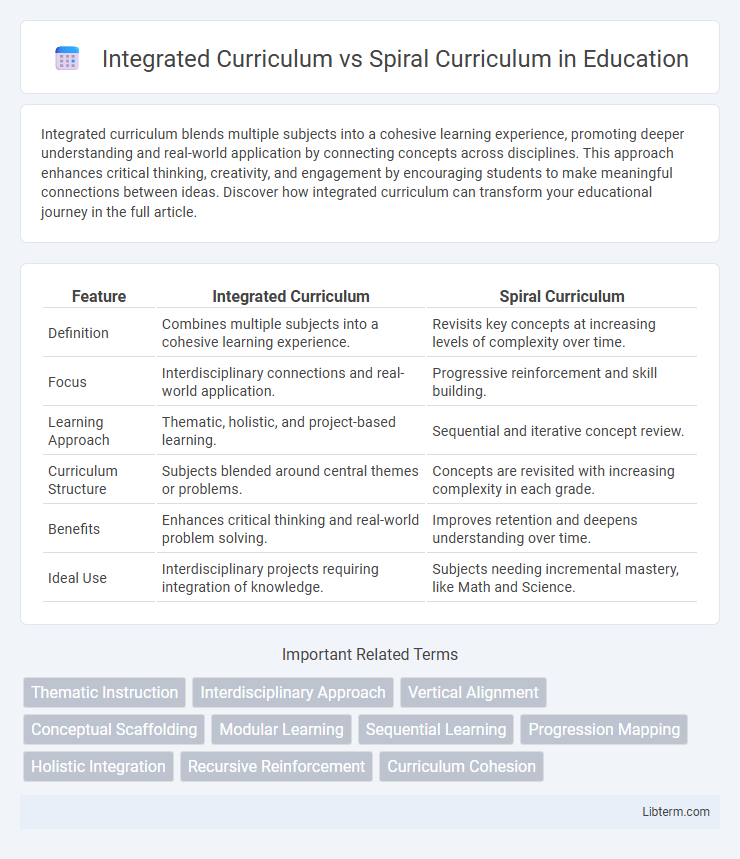Integrated curriculum blends multiple subjects into a cohesive learning experience, promoting deeper understanding and real-world application by connecting concepts across disciplines. This approach enhances critical thinking, creativity, and engagement by encouraging students to make meaningful connections between ideas. Discover how integrated curriculum can transform your educational journey in the full article.
Table of Comparison
| Feature | Integrated Curriculum | Spiral Curriculum |
|---|---|---|
| Definition | Combines multiple subjects into a cohesive learning experience. | Revisits key concepts at increasing levels of complexity over time. |
| Focus | Interdisciplinary connections and real-world application. | Progressive reinforcement and skill building. |
| Learning Approach | Thematic, holistic, and project-based learning. | Sequential and iterative concept review. |
| Curriculum Structure | Subjects blended around central themes or problems. | Concepts are revisited with increasing complexity in each grade. |
| Benefits | Enhances critical thinking and real-world problem solving. | Improves retention and deepens understanding over time. |
| Ideal Use | Interdisciplinary projects requiring integration of knowledge. | Subjects needing incremental mastery, like Math and Science. |
Understanding Integrated Curriculum: Definition and Key Features
Integrated Curriculum merges multiple subject areas into a cohesive learning experience, promoting connections across disciplines and real-world application. Key features include thematic units, interdisciplinary projects, and collaborative teaching strategies that enhance critical thinking and problem-solving skills. This approach fosters deeper understanding by enabling students to see relationships between concepts rather than learning in isolated content silos.
Exploring Spiral Curriculum: Principles and Structure
The spiral curriculum is designed to revisit key concepts at increasing levels of complexity, reinforcing learning through repetition and gradual progression. Its core principle involves structuring content so that students build on prior knowledge systematically, allowing deeper understanding over time. This approach contrasts with integrated curricula by emphasizing cyclic reinforcement and staged intellectual development.
Core Differences Between Integrated and Spiral Curricula
Integrated curriculum combines multiple subject areas into a cohesive learning experience, emphasizing thematic connections and real-world applications, while spiral curriculum revisits the same topics repeatedly over time, each iteration increasing in complexity and depth. Integrated curriculum fosters interdisciplinary understanding by blending concepts from various disciplines simultaneously, whereas spiral curriculum reinforces mastery through systematic review and progressive expansion of knowledge. The core difference lies in integrated curriculum's horizontal breadth across subjects versus spiral curriculum's vertical depth through cyclical content revisiting.
Benefits of Integrated Curriculum in Modern Education
Integrated curriculum enhances student engagement by connecting multiple subjects around thematic units, promoting deeper understanding and real-world application. This approach improves critical thinking and problem-solving skills by encouraging interdisciplinary connections and collaborative learning. Modern education benefits from integrated curriculum as it fosters creativity, adaptability, and prepares students for complex, dynamic environments.
Advantages of Spiral Curriculum for Student Learning
The Spiral Curriculum enhances student learning by revisiting core concepts at increasing levels of complexity, promoting deeper understanding and long-term retention. By building on prior knowledge through repeated exposure, students develop stronger connections between topics and improved critical thinking skills. This method supports individualized learning paces, allowing learners to master foundational ideas before advancing, resulting in more effective knowledge acquisition.
Challenges and Limitations of Integrated Curriculum
Integrated curriculum often faces challenges such as difficulties in aligning diverse subject standards and the extensive collaboration required among teachers from different disciplines. Limited teacher expertise in multiple subjects can hinder effective implementation, leading to gaps in content coverage and depth. Scheduling constraints and assessment complexities further restrict its consistent application across varied educational settings.
Potential Drawbacks of Spiral Curriculum
The Spiral Curriculum may lead to redundancy and learner frustration due to repeated exposure to similar content without significant depth or progression. This approach can cause confusion if foundational topics are not thoroughly mastered before revisiting more complex concepts. Limited flexibility in pacing often hinders personalized learning experiences, potentially impeding students who require more time to fully grasp initial material.
Effective Subject Integration in Integrated Curriculum Approaches
Integrated curriculum approaches effectively blend multiple subjects around common themes, promoting deeper understanding and real-world application through interconnected lessons. This strategy enhances cognitive connections by linking concepts across disciplines, facilitating knowledge transfer and retention. Research shows students in integrated curricula demonstrate higher engagement and improved critical thinking skills compared to traditional segmented learning.
Long-term Student Outcomes: Integrated vs Spiral Curriculum
Integrated curriculum promotes long-term student outcomes by fostering interdisciplinary connections, improving critical thinking, and enhancing knowledge retention through applying concepts across subjects. Spiral curriculum supports long-term learning by revisiting core topics at increasing levels of complexity, reinforcing understanding and facilitating mastery over time. Both approaches contribute to enduring academic skills, but integrated curriculum emphasizes holistic comprehension while spiral curriculum prioritizes incremental skill development.
Choosing the Right Curriculum Model for Your School
Choosing the right curriculum model for your school depends on aligning educational goals with student learning needs and subject integration. Integrated Curriculum fosters interdisciplinary connections, promoting deeper understanding by blending subjects, while Spiral Curriculum reinforces key concepts through repeated, progressively complex exposure enhancing retention and mastery. Evaluating factors such as teacher expertise, student adaptability, and resource availability ensures selecting the model that optimizes engagement and academic success.
Integrated Curriculum Infographic

 libterm.com
libterm.com